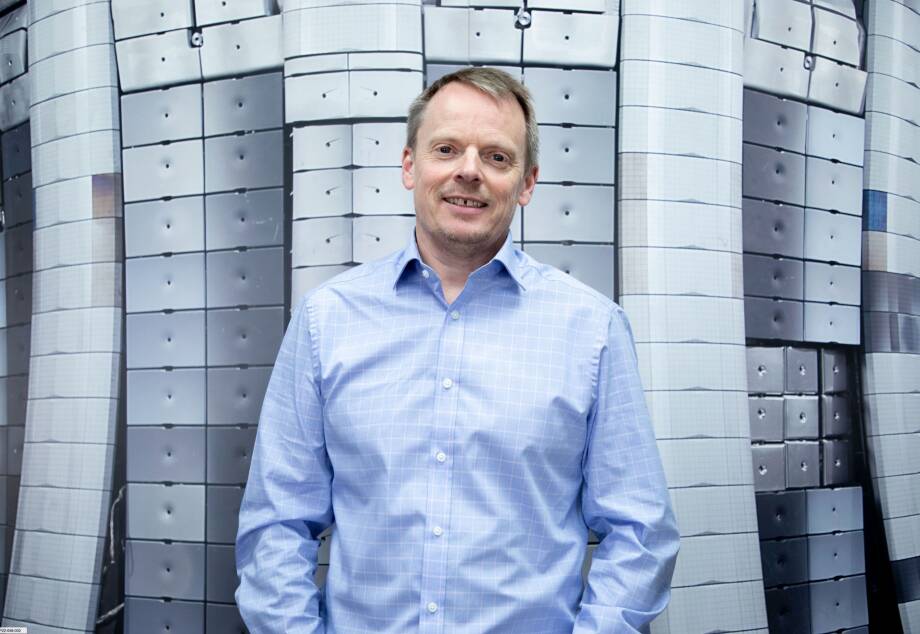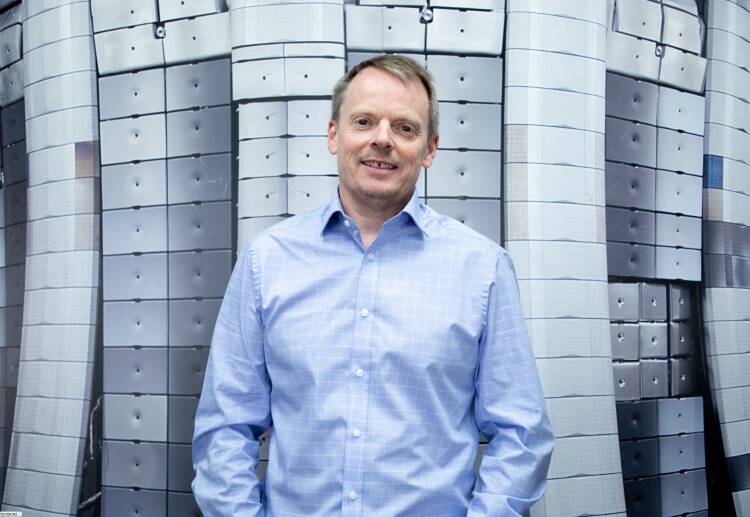Spotlight Interview: James Wilson
As fusion energy research accelerates, so must the technology that supports it. Diagnostics play a crucial role in understanding and refining fusion reactions, ensuring that experimental and commercial devices function as expected. This month, we spoke with James Wilson, a Senior Programme Manager at UKAEA, to delve into the critical role of fusion diagnostics and how UKAEA is partnering with external organisations to advance innovation in this field.
Can you tell us a bit about your role at UKAEA?
I oversee complex programmes that deliver plant and diagnostic systems for existing and emerging fusion energy power plants. My role also involves identifying spin-off opportunities that leverage fusion-related technologies for broader applications, helping to bridge the gap between cutting-edge research and real-world implementation.
What are fusion diagnostics, and why are they critical for fusion research?
Fusion diagnostics serve as the eyes and ears of a fusion machine, enabling us to measure key parameters such as temperature, pressure, and plasma behaviour. These systems are vital for

confirming that the fusion machine is operating within expected conditions and for analysing data from experiments. If outcomes deviate from predictions, diagnostics help pinpoint the cause, allowing researchers to refine their models and improve the machine's performance.
You previously worked on JET diagnostics - how has your focus evolved over time?
During my time on the JET project, I collaborated with international partners to support a multinational fusion research effort. As UKAEA expands its engagement with external organisations, my role has shifted towards working with commercial companies and government laboratories that are placing contracts with us. This has opened up new opportunities to apply our expertise to a more diverse and rapidly growing fusion market.
What are some exciting diagnostic projects you're working on with external organisations?
One of our key collaborations is with Novatron Fusion Group, where we are supporting the integration of diagnostics into their small-scale fusion machines—an approach that presents unique engineering challenges. We are also working with Commonwealth Fusion Systems to develop advanced calibration tools for neutron flux measurement, which is essential for monitoring fusion reactions accurately and safely.
What are the biggest challenges in developing diagnostics for future fusion power plants?
The transition from research-based to commercial fusion power plants presents several challenges. One of the biggest hurdles is scaling down the size and cost of diagnostic systems while maintaining their effectiveness. Additionally, as fusion technology evolves, machines are using different types of plasma and plasma-facing materials, requiring innovative diagnostic designs that can adapt to these variations. Lead times for delivery also remain a critical factor in ensuring the timely deployment of these systems.
As fusion progresses toward commercialisation, how do you see the role of diagnostics changing?
Diagnostics will always be essential, but their function will shift as fusion power plants move from research to routine operations. While experimental machines require a vast array of diagnostic tools to gather extensive data, commercial fusion machines will demand more streamlined, plug-and-play solutions. These systems must be robust, easily maintainable, and capable of providing real-time monitoring with minimal human intervention.
Are there any emerging technologies in diagnostics that you find promising?
Rather than focusing on specific technologies, we are prioritising the development of configurable diagnostic systems. These systems will feature a core standardised framework while allowing for customisation at the interface with different fusion devices. This approach will enable greater flexibility, compatibility, and efficiency as the industry scales up.
What do you enjoy most about working at UKAEA?
One of the most rewarding aspects of working at UKAEA is the opportunity to collaborate with incredibly talented teams who are passionate about advancing fusion energy. The level of commitment and innovation here is truly inspiring. I’ve also had the privilege of working on cutting-edge engineering technologies that push the boundaries of scientific research. Knowing that our work has a global impact on the future of sustainable energy is both exciting and fulfilling.
Fusion diagnostics are at the forefront of making fusion energy a reality. With UKAEA’s decades of hands-on experience and extensive collaborations, we are uniquely positioned to drive advancements in this critical area. As world leaders in the field of fusion diagnostics, we are proud to play a pivotal role in shaping the future of energy. The road to commercial fusion is filled with challenges, but through innovation, strategic partnerships, and cutting-edge diagnostics, we are steadily moving closer to unlocking a limitless source of clean energy.
Spotlight Interview: James Wilson
As fusion energy research accelerates, so must the technology that supports it. Diagnostics play a crucial role in understanding and refining fusion reactions, ensuring that experimental and commercial devices function as expected. This month, we spoke with James Wilson, a Senior Programme Manager at UKAEA, to delve into the critical role of fusion diagnostics and how UKAEA is partnering with external organisations to advance innovation in this field.
Can you tell us a bit about your role at UKAEA?
I am James Wilson, Senior Programme Manager at UKAEA. I oversee complex programmes that deliver plant and diagnostic systems for existing and emerging fusion energy power plants. My role also involves identifying spin-off opportunities that leverage fusion-related technologies for broader applications, helping to bridge the gap between cutting-edge research and real-world implementation.
What are fusion diagnostics, and why are they critical for fusion research?
Fusion diagnostics serve as the eyes and ears of a fusion machine, enabling us to measure key parameters such as temperature, pressure, and plasma behaviour. These systems are vital for confirming that the fusion machine is operating within expected conditions and for analysing data from experiments. If outcomes deviate from predictions, diagnostics help pinpoint the cause, allowing researchers to refine their models and improve the machine's performance.

You previously worked on JET diagnostics - how has your focus evolved over time?
During my time on the JET project, I collaborated with international partners to support a multinational fusion research effort. As UKAEA expands its engagement with external organisations, my role has shifted towards working with commercial companies and government laboratories that are placing contracts with us. This has opened up new opportunities to apply our expertise to a more diverse and rapidly growing fusion market.
What are some exciting diagnostic projects you're working on with external organisations?
One of our key collaborations is with Novatron Fusion Group, where we are supporting the integration of diagnostics into their small-scale fusion machines—an approach that presents unique engineering challenges. We are also working with Commonwealth Fusion Systems to develop advanced calibration tools for neutron flux measurement, which is essential for monitoring fusion reactions accurately and safely.
What are the biggest challenges in developing diagnostics for future fusion power plants?
The transition from research-based to commercial fusion power plants presents several challenges. One of the biggest hurdles is scaling down the size and cost of diagnostic systems while maintaining their effectiveness. Additionally, as fusion technology evolves, machines are using different types of plasma and plasma-facing materials, requiring innovative diagnostic designs that can adapt to these variations. Lead times for delivery also remain a critical factor in ensuring the timely deployment of these systems.
As fusion progresses toward commercialisation, how do you see the role of diagnostics changing?
Diagnostics will always be essential, but their function will shift as fusion power plants move from research to routine operations. While experimental machines require a vast array of diagnostic tools to gather extensive data, commercial fusion machines will demand more streamlined, plug-and-play solutions. These systems must be robust, easily maintainable, and capable of providing real-time monitoring with minimal human intervention.
Are there any emerging technologies in diagnostics that you find promising?
Rather than focusing on specific technologies, we are prioritising the development of configurable diagnostic systems. These systems will feature a core standardised framework while allowing for customisation at the interface with different fusion devices. This approach will enable greater flexibility, compatibility, and efficiency as the industry scales up.
What do you enjoy most about working at UKAEA?
One of the most rewarding aspects of working at UKAEA is the opportunity to collaborate with incredibly talented teams who are passionate about advancing fusion energy. The level of commitment and innovation here is truly inspiring. I’ve also had the privilege of working on cutting-edge engineering technologies that push the boundaries of scientific research. Knowing that our work has a global impact on the future of sustainable energy is both exciting and fulfilling.
Fusion diagnostics are at the forefront of making fusion energy a reality. With UKAEA’s decades of hands-on experience and extensive collaborations, we are uniquely positioned to drive advancements in this critical area. As world leaders in the field of fusion diagnostics, we are proud to play a pivotal role in shaping the future of energy. The road to commercial fusion is filled with challenges, but through innovation, strategic partnerships, and cutting-edge diagnostics, we are steadily moving closer to unlocking a limitless source of clean energy.